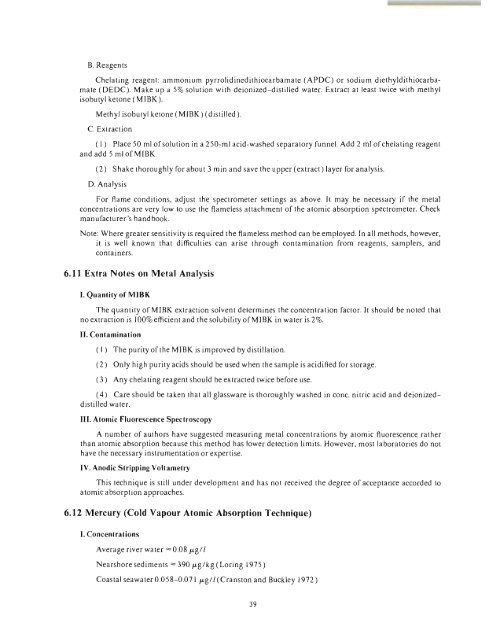Create successful ePaper yourself
Turn your PDF publications into a flip-book with our unique Google optimized e-Paper software.
B. Reagents<br />
Chelating reagent: ammonium pyrrolidinedithiocarbamate (APDC) or sodium diethyldithiocarbamate<br />
(DEDC). Make up a 5% solution with deionized-distilled water. Extract at least twice with methyl<br />
isobu tyl ketone (MIBK).<br />
Methyl isobutyl ketone (MIBK) (distilled).<br />
C. Extraction<br />
(I) Place 50 ml of solution in a 250-ml acid-washed separatory funnel. Add 2 ml ofchelating reagent<br />
and add 5 ml of MIBK.<br />
(2) Shake thoroughly for abou t 3 min and save the upper (extract) layer for analysis.<br />
D. Analysis<br />
For flame conditions, adjust the spectrometer settings as above. It may be necessary if the metal<br />
concentrations are very low to use the flameless attachment of the atomic absorption spectrometer. Check<br />
manufacturer's handbook.<br />
Note: Where greater sensitivity is required the flameless method can be employed. In all methods, however,<br />
it is well known that difficulties can arise through contamination from reagents, samplers, and<br />
containers.<br />
6.11 Extra Notes on Metal Analysis<br />
I. Quantity of MIBK<br />
The quantity of MIBK extraction solvent determines the concentration factor. It should be noted that<br />
no extraction is 100% efficient and the solubility of MIBK in water is 2%.<br />
II. Contamination<br />
( I) The purity of the MIBK is im proved by distillation.<br />
(2) Only high purity acids should be used when the sample is acidified for storage.<br />
(3) Any chelating reagent should be extracted twice before use.<br />
(4) Care should be taken that all glassware is thoroughly washed in conc. nitric acid and deionizeddistilled<br />
water.<br />
III. Atomic Fluorescence Spectroscopy<br />
A number of authors have suggested measuring metal concentrations by atomic fluorescence rather<br />
than atomic absorption because this method has lower detection limits. However, most laboratories do not<br />
have the necessary instrumentation or expertise.<br />
IV. Anodic Stripping Voltametry<br />
This technique is still under development and has not received the degree of acceptance accorded to<br />
atomic absorption approaches.<br />
6.12 Mercury (Cold Vapour Atomic Absorption Technique)<br />
I. Concentrations<br />
Average river water"" 0.08 j.tgl I<br />
Nearshore sediments"" 390 j.tg/kg (Loring 1975)<br />
Coastal seawater 0.058-0.071 j.tgl I (Cranston and Buckley 1972)<br />
39

















